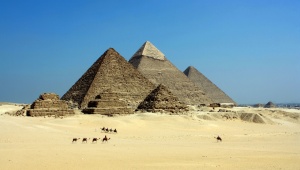
The pyramids
How far back do you think project management goes?
- 2570 BCE: The Great Pyramid of Giza completed
- 208 BCE: Construction of the Great Wall of China
- 1917: The Gantt chart developed by Henry Gantt (1861-1919)
- 1956: The American Association of Cost Engineers (now AACE International) formed
- 1957: The Critical Path Method (CPM) invented by the Dupont Corporation
- 1958: The Program Evaluation Review Technique (PERT) invented for the U.S. Navy’s Polaris Project
- 1962: United States Department of Defense mandate the Work Breakdown Structure (WBS) approach
- 1965: The International Project Management Association (IPMA) founded
- 1969: Project Management Institute (PMI) launched to promote the Project Management profession
- 1975: PROMPTII method created by Simpact Systems Limited
- 1975: The Mythical Man-Month: Essays on Software Engineering by Fred Brooks
- 1984: Theory of Constraints (TOC) introduced by Dr. Eliyahu M. Goldratt in his novel “The Goal”
- 1986 Scrum named as a Project Management Style
- 1987: A Guide to the Project Management Body of Knowledge (PMBOK Guide) published by PMI
- 1989: Earned Value Management (EVM) Leadership elevated to Undersecretary of Defense for Acquisition
- 1989: PRINCE Method developed From PROMPTII
- 1994: CHAOS Report first published
- 1996: PRINCE2 published by CCTA
- 1997: Critical Chain Project Management (CCPM) invented
- 1998: PMBOK becomes a standard
- 2001: The Agile Manifesto written
- 2006: “Total Cost Management Framework” released by AACE International
- 2008: 4th edition of PMBOK Guide released
- 2009: Major PRINCE2 revision by Office of Government Commerce (OGC)
- 2012: ISO 21500:2012 Standard for Project Management released
- 2012: 5th Edition of PMBOK Guide released
Forum - Reflection on the history and future of project management
Review the dynamic time line depicting the history of project management published by Project Smart.
- Log in to forums.oeru.org (Sign up to register a new account if your don’t already have one.)
- Consider the following questions:
- What do you think is the most significant milestone for project management? Why?
- What do you think is the most important challenge for the future of project management? Why?
- Post your thoughts on these questions and join the discussion on the history and future of project management
Read the section History in the prescribed textbook (Web | PDF), Chapter 1 (pages 7 and 8 in the PDF version).
How far back do you think project management goes?
Forum - Reflection on the history and future of project management
Review the dynamic time line depicting the history of project management published by Project Smart.
Reading
Read the section History in the prescribed textbook (Web | PDF), Chapter 1 (pages 7 and 8 in the PDF version).